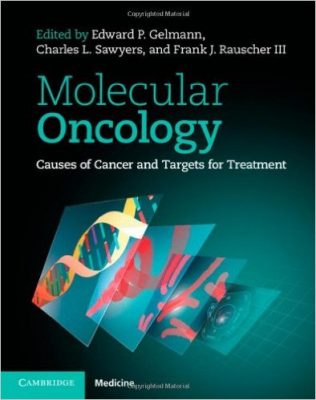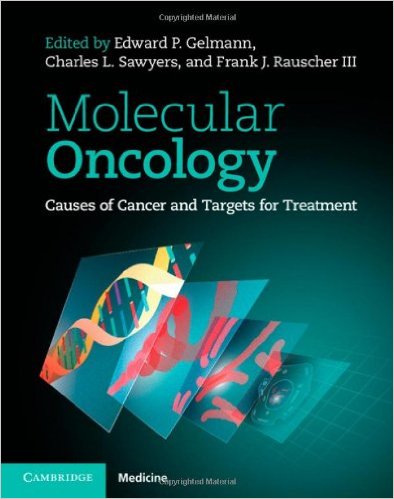 Editors: Edward P. Gelmann, MD; Charles L. Sawyers, MD; and Frank J. Rauscher III, MD
Editors: Edward P. Gelmann, MD; Charles L. Sawyers, MD; and Frank J. Rauscher III, MD
Publisher: Cambridge University Press – 961 pages
Book Review by: Nano Khilnani
This book essentially summarizes the biochemistry, molecular pathophysiology, targeted therapeutics, and technology used in studying and fighting cancer. It is for use by researchers in academia and the drug industry; and by medical students, residents, and practitioners.
Because research about cancer has been growing in volume and pace, books on this are become outdated as soon as they are published. Books such as this one do not contain the most current laboratory discovery or the most recent drug approved by the U.S. Food and Drug Administration.
But this book does contain some major advances in molecular oncology:
- The Cancer Genome Atlas, found at CancerGenome.NIH.Gov has demonstrated the broad spectrum of mutations in an expanding list of cancers
- DNA sequence analysis alone has demonstrated that as cancers grow, metastasize, and develop resistance, individual tumor sites within a patient evolve differently and demonstrate increasingly complex spectra of driver and passenger mutations.
- The complexities of cellular disregulation may arise from DNA sequence changes, but extend to other levels of gene regulation
- During the writing of this book the role of micro-RNAs (miRNAs) was elucidated
- Aberrations in epigenetics such as DNA methylation and histone acetylation were demonstrated
The above points show us that as the findings from studies were written for this book, new findings were discovered and added to it. Another positive outcome in recent years is that cancer drug development has also accelerated: in the 2008-2012 period there were 51 approvals of new cancer-treatment drugs by the FDA. Many of these approvals were as a result of impressive data in Phase II trials that showed efficacy where no agents had worked before.
Over 200 specialists including the editors named above working in cancer research and treatment, from all over the United States and 16 other countries – Australia, Canada, China, Denmark, France, Germany, Israel, Italy, Japan, the Netherlands, Singapore, South Korea, Spain, Sweden, Switzerland, and the United Kingdom – authored the 90 chapters in this and outstanding and highly useful text.
Too many to name the titles of the chapters here, the material in this wide-ranging book is organized around four broad Parts and within them, 16 sub-parts which we list below so that you the student or physician in oncology can have an overview of the contents in this important work:
- Part 1.1 Analytical Techniques: analysis of DNA
- Part 1.2 Analytical Techniques: analysis of RNA
- Part 2.1 Molecular pathways underlying carcinogenesis: signal transduction
- Part 2.2 Molecular pathways underlying carcinogenesis: apoptosis
- Part 2.3 Molecular pathways underlying carcinogenesis: nuclear receptors
- Part 2.4 Molecular pathways underlying carcinogenesis: DNA repair
- Part 2.5 Molecular pathways underlying carcinogenesis: cell cycle
- Part 2.6 Molecular pathways underlying carcinogenesis: other pathways
- Part 3.1 Molecular pathology: carcinomas
- Part 3.2 Molecular pathology: cancers of the nervous system
- Part 3.3 Molecular pathology: cancers of the skin
- Part 3.4 Molecular pathology: endocrine cancers
- Part 3.5 Molecular pathology: adult sarcomas
- Part 3.6 Molecular pathology: lymphoma and leukemia
- Part 3.7 Molecular pathology: pediatric solid tumors
- Part 4.0 Pharmacologic targeting of oncologic pathways
The materials – text and graphics – provided in the chapters are organized and presented well to make study productive and retention easier. Let us take a look at a typical chapter like chapter 2 – Genome-wide association studies of cancer predisposition. This chapter’s authors Zsofia K. Sadler, Sohela Shah, ands Kenneth Offit provide an Introduction, five topics of discussion, two charts, two Tables, a Conclusion, Acknowledgements, and an extensive list of 140 References:
Introduction
The genetics of cancer predisposition
Experimental design of genome-wide association studies
Genome-wide association study interpretation
Lessons from genome-wide association studies in cancer
Challenges and clinical limitations
Conclusion
Acknowledgments
References
In their Conclusion the authors acknowledge that recent technological advancements have extensively improved scientists’ capacity to study genomic variations across different populations, and have identified associations between single nucleotide polymorphisms (SNPs) and a variety of malignancies.
The authors also conclude that while analysis of common genetic variants in their chapter has provided increased understanding, ongoing studies of structural variation and planned analysis of individual sequence differences (rare variants) will vastly improve understanding of the genetic mechanisms of cancer susceptibility. They also write that ‘considerable translational effort’ is needed to use the current available information from genomic association studies and incorporate them into ‘preventive medical and oncologic practice.’
This is an excellent, highly informative work in the field of medical oncology.
Editors:
Edward P. Gelmann, MD is Chief of the Division of Hematology/Oncology, and Deputy Director of Research at Herbert Irving Comprehensive Cancer Center at Columbia University Medical Center in New York, New York.
Charles L. Sawyers, MD is Chair of the Human Oncology and Pathogenesis Program at Memorial Sloan-Kettering Cancer Center in New York, New York; and Investigator at the Howard Hughes Medical Institute in Chevy Chase, Maryland.
Frank J. Rauscher III, MD is Professor in the Gene Expression and Regulation Program, and Tumor Microenvironment and Metastasis Program; and Director of Basic Research at Wistar Institute Cancer Center in Philadelphia, Pennsylvania.







